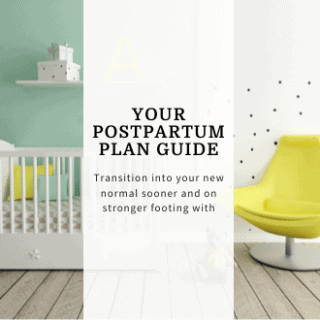We all know that a woman’s body changes after giving birth. The disconnect seems to be with why the body changes and how to address any changes that we’d like to, well, address. There is so much information out there, and a lot of information missing. It is easy to get lost while trying to navigate a way forward and it’s easy to get overwhelmed when we don’t see the results we may be trying to achieve.
This is why we were so excited to host Pilates instructor Charlotte Blake Kaplan on our latest webinar. Charlotte specializes in working with postpartum women and has personally experienced the challenges of getting back into a workout routine after the birth of her one-year-old. Here’s what she had to share with us.
Meet Charlotte
Charlotte: So I’m Charlotte Blake Kaplan. And I have been a Pilates teacher for eight years and was a personal trainer for years before that. And I have a one-year-old, who’s actually 15 months old in a few days. And I have a very interesting experience with working with mostly postnatal women, because I started working with them in my twenties and through my personal training and Pilates work supported a lot of pre and postnatal women. And so even knowing what I knew, I was very surprised through my pregnancy realizing just how hard it is on the body. And I personally was very sick for four months of my pregnancy. So it was just really hard on my body. And then the postpartum period was so much of a challenge and very taxing.
Charlotte: Just take a moment and say, I own a Pilates studio in the city, in Greenwich Village. Obviously I’ve gone digital, and so really focusing a lot of my time to supporting post-natal women, because people are still having babies, and something I was thinking, this is called what you don’t learn of the six week checkup. And even those six week appointments, a lot of them are being canceled right now. So I’m really glad that you’re here. I’m hoping that this helps you just build your new foundation. And I’ll talk about what that even means, building a new foundation for your body.
Charlotte: Previous client I’d worked with throughout her pregnancy and postpartum, DM’ed and she was like, “You’re going to need a much longer workshop for that,” because there is so much to learn. And I think one of the things that I loved so much in my twenties… Sometimes I’m like, “Why when I was 25 did I want to work with pre, post natal women?” But what I found, especially for postnatal people is that there’s this new… Unless someone’s been injured or had a traumatic experience with their body, most people who have babies have the experience of, they’ve pretty much known what to do for their body, like pretty much known how to exercise, how to be in shape, how to feel strong, how to… And you know the avenues to go find those things. So then suddenly we’re all in this collective experience of basically going through a physical trauma. Maybe it feels… Some people call pregnancy an injury, because you come out of it experiencing so much weakness and trauma in your body, and there’s so much to rebuild.
Charlotte: So I think it’s actually this really beautiful time where a lot of times for the first time in people’s lives, they’re suddenly like, okay, I want to learn about my body. What is this muscle? How do the pieces and parts fit together? And then I think I’m trying to bridge that gap, because what a lot of people are told at the six week visit is, “You can do whatever you were doing before.” And also there’s a part of it that’s like, I don’t even know what I was doing before. What was I doing? Just with everything. What was my life before my baby? And that’s not always the best advice, because if someone was running a lot before, and then all of a sudden they’re feeling pelvic floor weakness or they’re just suddenly feel like they can’t engage abdominals, then going out and running on concrete is going to be detrimental to your body. So there is that need to rebuild a foundation and get to know your body.
What’s different after the baby gets here?
Karolina: What’s different? So why can’t you just go back to what you did before, even if you let’s say, have a relatively uneventful pregnancy and delivery?
Charlotte: First of all, your abdominals stretch out. So that feeling of, Oh my gosh, I have no abs, is actually… You were pregnant, right? So then your abdominals were pulling back on the baby. And then all of a sudden not pregnant. And so then your brain doesn’t know how to fire your abdominals. So it’s not that they’re not there. It’s just having to re-teach your mind and body connection, which is an actual neurological connection. It’s not like a woo woo idea. So first of all, it’s bringing awareness back to your abdominals and just teaching your abdominals how to engage. And that’s not through the traditional, I’m going to go take this arms and abs class at the gym. It’s really through breathing. So we’ll go through that exercise or we’ll go through breathing and the correct way to breathe. And I’ll explain why that’s important anatomically and why it’s like the number one tool that you want in your toolbox and exactly how you’re going to rebuild your strength. Again, it’s not a woo woo thing. It is anatomically how your abdominals rebuild and how they’re meant to fire throughout everyday life.
What happens to the pelvic floor after birth?
Charlotte: And then the pelvic floor. So you were pregnant. Pelvic floor was responsible for lot of stability, holding weight. And so if there was a vaginal birth, then a lot of times the pelvic floor needs some healing, needs some time. So also in that six week time, that’s when the tissue of the perineum is just starting to heal. So it’s not an indication of how your pelvic floor is going to be feeling for the rest of your life. So that was one of my fears too. Oh my goodness. Like six weeks, I’m not feeling good at all. I was feeling very weak. Sex was still painful. And so some of it is time.
Charlotte: And then also just understanding the function of the pelvic floor, how it functions with the diaphragm. So again, going back to breath and how it functions with the abdominals. So healing this core like abdominals and pelvic floor is also something that can happen together, is meant to happen together. They work together. So it’s not like, I’ve got to work on my pelvic floor. I’ve got to work on my abs. It’s actually a symbiotic relationship and it can happen together. And then part of it too, is being aware of your posture and how you’re holding your body, which is hard for a new mom, because we have to put our body in these crazy positions to take care of a baby. So as much as possible, finding strength in your stabilizing muscles, and knowing too where to release and stretch your body.
Strengthening the abs after pregnancy
Charlotte: So part of the stabilizing muscles are breaking down and understanding what abdominals even are. So most people know of the six pack muscles. Those are the muscles that run from the base of your rib cage all the way down to your pubic bone. So those are the rectus abdominis muscles. Those are the muscles that can separate during pregnancy. So that would be where the abdominal diastisis is happening. So it’s not that the muscles tear, it’s that the connective tissue between those muscles gets super lax, because you have the hormone relaxant in your body. And so they can slightly separate. So then underneath that, you have your obliques, your external obliques, your internal obliques, and then underneath that you have your transversus abdominis. So I like to call it your core of your pore. So they’re muscles that wrap from your back around to the front. And they go up to the rib cage all the way down into your pelvis. So they act almost like a corset. So if you had one of those corsets or those wraps that you wore after having your baby, that just mimics what your internal abdominal muscle does. So that’s your core.
Charlotte: So when we think about strengthening abdominals, I’m trying to teach people to get away from thinking of the superficial muscles. Those are these outer most muscles, that’s what you use when you’re bending over, being more active. So that’s going to be dynamically moving your body. Then the inner most abdominal muscles, those are the stabilizers. That’s what helps keep you upright and out of pain. And because it wraps from your back, it really helps protect the back as well. So okay. And also, I keep doing this, because I’m trying to make it clear that those muscles wrap. That’s going to be also what helps bring a diastisis closed.
Charlotte: So if you wanted to check yourself and you’re not going to hurt yourself by doing this, and you can always ask… This is hard. So you can always ask someone to check you, but we’re not living in that day and age right now. So you can go on your back with your hands behind your head and just take a nice, deep inhale, exhale, lift head and shoulders up, take your hand and just right in the middle, down the middle of the front of your torso, feel and see if you feel… You would feel the two sides of that rectus abdominis.
Charlotte: If you feel the space, my plea to you is not to panic. I even still have a small one, and I had a two and a half finger diastisis right after I had my baby. And I’m a Pilates instructor, and I did Pilates my entire pregnancy. So it’s just something that happens. It’s completely normal. And then you can work to close it. And a lot of that is what I’m talking about today, just getting into your abdominals and finding those deep core muscles and finding your breath, and bringing awareness to how you’re holding your body.
 How can a woman tell that her pelvic floor is weak?
How can a woman tell that her pelvic floor is weak?
Karolina: Just tell us a little bit about if your pelvic floor is weak, what are the symptoms you might have or what might it feel like?
Charlotte: It’s tricky, because sometimes weakness symptoms are also when a pelvic floor overworks, although that doesn’t necessarily mean it’s stronger. But you could have leaking. If there’s a feeling of pressure or things are just kind of like you just can’t control, incontinence, not making it to the bathroom in time.
Charlotte: That’s where the breathing is so important, because sometimes it’s not even necessarily, Oh, your pelvic floor is weak. You need to do Kegels, because you peed when you sneezed. Sometimes it’s understanding how to regulate that intra abdominal pressure that I was talking about when the diaphragm descends down. So a lot of times it’s just understanding that piston of diaphragm and pelvic floor, and waking up that dynamic system.
Charlotte: I like to use… That’s why I grabbed this ball. It’s like, if this is your canister, your torso, and you’re doing what I was doing when I was feeling self conscious about baby weight being a Pilates teacher, which that’s a whole different webinar about confidence and self-acceptance, that was my journey at the time. Okay. So I was really squeezing in here, right? So then see what that does? Especially for pelvic floor. That would add a lot of pressure to the pelvic floor. And then also if the pelvic floor, if it’s a hypertonic pelvic floor, there’s a lot of pulling up. There’s a lot of fear like, Oh, I don’t want to have a weak pelvic floor. I’m going to pull up, I’m going to pull up. I’m going to squeeze. Right? So then it’s just really pressing up. Then the diaphragm isn’t going to be able to descend down.
Charlotte: And then you can see as much as possible with the ball, when that pressure isn’t regulated, maybe the pelvic floor is really pushing, the diaphragm can’t really do its work, the abdominals are pulling in tight, and then you go to sneeze, there’s no room for anything to… Something’s got to give. so that’s when herniations can happen or there could be a little bit of leaking. Yeah. So it’s one of those things too, where I wish it was, Oh, this happening, do this, but it does take some guidance, some information, and some mindfulness for yourself, which I know is also hard when you’re taking care of a baby and maybe also kids in addition to that, but even just a little bit of awareness can go a really long way.
Charlotte: It’s almost like you are training your body. So what I see people do is six weeks, they want to get in shape, so they go running. After you’ve been pregnant for nine or 10 months, and then you’ve gone through the fourth trimester, especially then, you don’t run to get into shape, you get into shape so that you can run. So it is rebuilding your foundation, which means finding your abdominal strength again.
Charlotte: Time and time again, I’ve been working with pre and postnatal women for 10 years. I see people getting the strongest they’ve ever been because they took the time to get to know their bodies, to find their for real strength, not the like, okay, I’m just going to do whatever by [inaudible 00:15:56] and stuff. So I’ve seen people getting inside out strong, and having so much knowledge that wasn’t there before. So I think it’s a really… It’s frustrating. And also it’s a really beautiful time where I see people truly finding their strength in a way that they never knew they could.
Meet Charlotte Blake Kaplan

You may also enjoy:
How to get started with post-pregnancy fitness
 How can a woman tell that her pelvic floor is weak?
How can a woman tell that her pelvic floor is weak?


